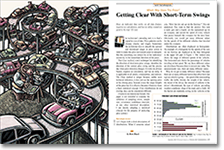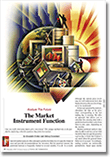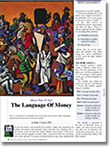Letters To The Editor
March 2011 Letters To The Editor
The editors of S&C invite readers to submit their opinions and information on subjects relating to technical analysis and this magazine. This column is our means of communication with our readers. Is there something you would like to know more (or less) about? Tell us about it. Without a source of new ideas and subjects coming from our readers, this magazine would not exist.
Address your correspondence to: Editor, Stocks & Commodities, 4757 California Ave. SW, Seattle, WA 98116-4499, or E-mail to editor@traders.com. All letters become the property of Technical Analysis, Inc. Letter-writers must include their full name and address for verification. Letters may be edited for length or clarity. The opinions expressed in this column do not necessarily represent those of the magazine. —Editor
THE CLEAR METHOD
 Editor,
Editor,
It was with great interest that I read Ron Black’s article in the September 2010 issue of your magazine, “Getting Clear With Short-Term Swings.” The concept is simple and signals are easy to follow (the best starting point for any indicator!).
In the article, the author provided the EasyLanguage code for displaying the swing line. But since many readers want to implement indicators using a spreadsheet, I decided to translate the Clear method to Excel.
I am providing a spreadsheet with the Clear method applied to the S&P 500 (“Clear Spx.xls”) as well as a Word document explaining how to enter formulas in Excel. I have contacted the author, Ron Black, as a check, and he has now also contributed a macro code listing (SwingLine.xls) for those who may want to use it.
I hope this helps those readers who rely on Excel to exercise technical analysis.
—Marco Alves
Thank you for providing this Excel spreadsheet translation to share with other readers.
Readers will find these Excel files (Clear Spx.xls and SwingLine.xls) and Word file (“Implementing the Clear Method_Excel(R).doc”) available at our website at www.traders.com in the Subscriber Area. Login requires your subscriber number and last name. —Editor
PARABOLIC SAR FOR METASTOCK?
Editor,
I’ve been receiving this excellent magazine for many years and always look forward to the next issue. There have been many writeups in the magazine on Bollinger bands, but none for the parabolic Sar() for MetaStock (Eod). I’ve been unsuccessful when trying to add parabolic Sar() code to an explorer column and don’t understand why. Can you write a formula that could be added to the explorer?
—John Arthur
We have redirected your inquiry to MetaStock, since we don’t specialize in writing code. You might also wish to check user forums for posted solutions.
For those not familiar with it, the parabolic Sar (stop and reverse) was introduced in J. Welles Wilder’s classic 1978 book, New Concepts In Technical Trading Systems (Trend Research).
The following are some articles we’ve published on the parabolic Sar. These and other articles are available from our online store at www.traders.com.—Editor
- Stay In The Market With Stop-And-Reverse
(Working-Money.com, April 2002)
If you hate being out of the market, you should take a look at this system. The parabolic time/price system indicator was developed by J. Welles Wilder. Often referred to as parabolic Sar or simply Sar (for “stop and reverse”), the term comes from its appearance as a parabola when viewed on a chart.
By Rudy Teseo - Parabolics
(July 1997)
Here’s a look at the parabolic trading system, with details on the way it works and how it’s calculated.
By John Sweeney - Modifying The Parabolic Stop And Reversal
(April 1995 — with sidebar: “The Parabolic Trading System”)
The parabolic stop and reversal indicator is a popular trading tool, but it’s subject to false signals. Here’s how it can be modified to improve its performance.
By Dennis Meyers - The Parabolic Trading System
(November 1993)
Traders are always searching for methods with which to manage risk through the use of stop-loss orders. One method that has been proposed for determining stops is by using a mechanical formula based on the parabolic indicator, also known as the stop and reverse (Sar). How does it work?
By Thom Hartle - Setting Stops: A New Approach
(November 1989)
Skillfully selected exit points can often make a large difference between overall profit and loss. One commonly used exit strategy is J. Welles Wilder’s parabolic stop-and-reverse, or Sar.
By John Ehlers
JM INTERNAL BANDS
 Editor,
Editor,
I have a question about Koos van der Merwe’s article in the December 2010 issue of S&C, “Less Stress With The JM Internal Band.”
About that band trade: I am not using MetaStock charts. When he says to use a 15-period simple moving average (Sma) along with offsets of 2% above and 2% below the 15 line, would it be okay to substitute by using an 18-period and 12-period Sma as replacements for both of the 2% offset lines? I came up with 18 and 12 because 2% of 15 is 3 (that is, 15+3=18, 15-3=12).
In addition, I’m curious as to whether van der Merwe has done any testing with those bands on 15- or 30-minute charts. Am wondering how they would perform on currency charts.
—Greg
Koos van der Merwe replies:
I am afraid that substituting another moving average does not work as effectively. If you could tell me what program are you using to analyze the markets, I may be able to provide you with a formula that would help. Remember, a 15-period simple moving average (Sma) is adding up the closing price of the last 15 days and dividing it by 15. You then offset this moving average 2% above and 2% below. Using an 18-period moving average (MA) is taking the last 18 days and dividing it by 18. This does not give a 15-period MA offset upward. The same goes for the 12-period MA. I would suggest you invest in a program that will allow you to write a simple strategy such as the JM internal band.
I can’t say whether it will work on a 15-minute or 30-minute chart, since I have only used it for long-term investing. I doubt that it would work for short-term trading.
MORE ON THE JM INTERNAL BANDS
Editor,
I found Koos van der Merwe’s article in the December 2010 issue of S&C about the JM internal bands very interesting. I would like to adapt this method as part of my trading strategies.
I use MetaStock but am not good at programming explorations in MetaStock. Could van der Merwe advise me how to do that? Also, does he use other indicators for confirmation of a trade besides the Rsi?
—Greg
Edmond, OK
Koos van der Merwe replies:
Thank you for your email. Here is the formula for the indicator. Simply copy and paste it into the indicator builder in MetaStock.
Bnd:= Mov(C ,15 ,S ) ; UpBd:=1.02*Bnd; LwBd:=0.98*Bnd; UpBd; LwBd
To add it to an explorer, follow these instructions:
Open The Explorer. A.... Close. B.... Ref(CLOSE, -1) C.... Bnd:= Mov(C ,15 ,S ) ; UpBd:=1.02*Bnd; LwBd:=0.98*Bnd; UpBd D.... Bnd:= Mov(C ,15 ,S ) ; UpBd:=1.02*Bnd; LwBd:=0.98*Bnd; Ref(UpBd,-1) E.... Bnd:= Mov(C ,15 ,S ) ; UpBd:=1.02*Bnd; LwBd:=0.98*Bnd; LwBd F..... Bnd:= Mov(C ,15 ,S ) ; UpBd:=1.02*Bnd; LwBd:=0.98*Bnd; Ref(LwBd,-1) G. .... RSI(C ,14 ) Filter..... colA>colC AND colB<colD AND colG < 40
The above formula is for long only. For shorts, you must alter the filter using the “E” and “F” formula. Hope this helps.
MARKET INSTRUMENT FUNCTION
 Editor,
Editor,
The article “The Market Instrument Function” published in the December 2010 issue of S&C left me very enthusiastic about using this signals processing technique, but also perplexed as to how to do just that.
I have a background in engineering, but not in signals processing. After reviewing the “mathematical discussion” section several times, I still do not understand how to compute the E(t-tau) device instrument function. Computing the output from the input plus device instrument function is simple, but how does one compute the device instrument function from the input and output? I am interested in an expression of the type “E(t-tau)=…”
Could the authors provide an example calculation or further reading suggestions on computing the device instrument function from the input + output?
—Eric Lanoix
Vancouver, BC, Canada
Thank you for taking the time to review the mathematical discussion that coauthors Alexander Ershov and Aleksey Gerasimov provided in the article. I would recommend an Internet search for “Fredholm’s integral equations of the first kind.” There are several published papers on this topic that may give you further insight.—Editor
THE LANGUAGE OF MONEY
 Editor,
Editor,
After carefully rereading Walter Downs’ July 2010 S&C article, “The Language Of Money,” I am convinced there are major math and logic errors involved that significantly affect the data in the article’s Figure 1. He states on page 25 that the FB percentage of gain per trade is 8% for the case where Pct=0.30, Win=120%(F=2.2), Loss=40% (F=0.6), and P/L=3. The correct formula for fixed fractional trading is: 2.2∧0.3*0.6∧0.7=0.885/trade = 0.885∧30=$0.0265 for 30 trades.
1) If starting equity is $100, then the profit becomes: 100*0.0265-$100 = $-97.3. This is a serious loss of equity and is vastly different from the author’s calculated value of $1,006. There are two errors involved: 1) his formula is incorrect, and 2) expectancy=0.20. Therefore, the optimum bet (loss) is given by 0.20/(P/L) ratio= 20%/3= 6.7%, so that the author’s 40% bet is six times the optimum bet of 6.7% — little wonder a significant equity loss occurs. This incorrect use of the profit formula means all profit values (nine rows, two sets of data) calculated in Figure 1 are badly overstated and should be corrected.
2) Downs is trying to establish the tradeoff between profit and probability of success (Pos). By “logic” he scales from $100, Pos=25%, to $25, Pos=100%. But in actual practice, this is really a nonlinear relationship (his is a simple proportional scaling) as it can be calculated (for near Pos=100%, like 99.9%) by using the author’s Por program. At Loss=40% the Por=74% for FB trading, as the author correctly obtained (Pos=26%). If we now drop the loss level from 40% to 1%, the Por=0.001, and the Pos approaches 100% (actually, 99.9% — close enough). But now the profit becomes: (100*(1.03∧0.3*0.99∧0.7)∧30)-100=$5.65, a positive value of profit (as the bet is below the optimum level of 6.7%). Clearly, there is a nonlinear relationship between profit and Pos, as the loss (bet) level is changed and simple “logic” scaling is not applicable.
It is also worth pointing out that with two trading portfolios, the author’s “blow out” calculation of 74%*9%=6.7% is correct, but it should be clarified by calling it Por (FF) to signify the simultaneous failure of the two equities. The “normal” Por for the two trading equities, FB and RB, would be given by: Por=0.5*(74%+9%)=41.5%, signifying that the overall risk of failure of the two lies in between the two, as intuition would tell you. The author then calculates PP (probability of success) at 1-Por(FF)=1-0.07=93%, a correct calculation, but its meaning seems obscure, as it implies that 93% of the time the two trading portfolios have simultaneous success. I fail to see the significance of that. Of more importance is that the data of Figure 1 all pertains to FB betting by itself, independent of RB betting, and thus no such PP calculation (of FB and RB together) would be applicable anyway.
Another error in math seems to be that the author mixes up equity and profit. For very small values of loss (like 1%), the author’s equation is correct for equity: Ending equity = 100* (1+Bet*E)∧N=100*(1+0.4*0.20)∧30=$1,006, but profit is ending equity minus starting equity, which becomes $1,006-$100=$906. Similarly, his $81 calculation is really a loss of $-18.
In conclusion, it appears that the article has numerous errors in math and logic, and if the author agrees, he might consider recalculating the various values within the article.
—Tom Phillips
Author Walter Downs replies:
As to your first enumerated point: Calculating the percentages in a standard equation of returns, we see that the trader expects an average return of +8% per trade. How then can he have a negative expectation? It is obvious that your formula does not apply here.
As to your second point: As I stated in the article, this is not a mathematical equation, but rather a logical one. It is possibly incorrect, but it was only mentioned as a possible “spit-ball” for a ballpark figure of possible minimum return.
As to your aside regarding the “blow-out” calculation: Your intuition is incorrect. We are not trading two portfolios. The probability of a FB and RB blowout can be calculated as done in the article, because there are distinct probabilities that the RB may never be challenged at all, once FB betting is occurring. Therefore, the calculation of risk at 6.7% of total failure is accurate.
As to your comment regarding profit calculation, I did include the original $100 in the final result, although it is possible that the second figure should have been $181 rather than $81. Equity was not “reduced” by $18.